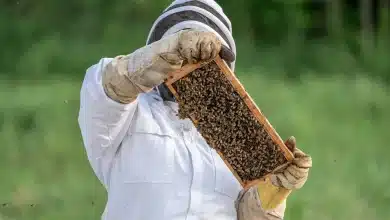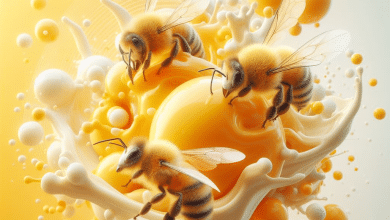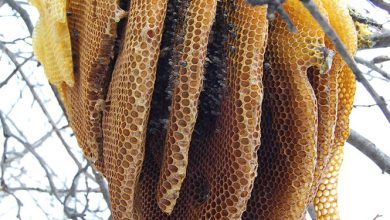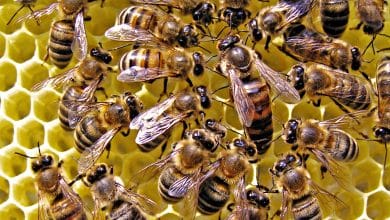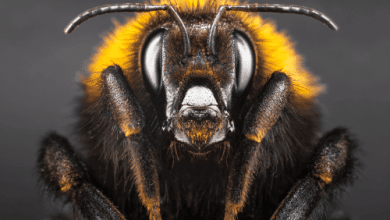Unveiling the Truth Are There Really Poisonous Bees?

Poisonous Bees. play a crucial role in the ecosystem as pollinators, making them indispensable for the reproduction of many plant species. The process of pollination occurs when bees collect nectar and pollen from flowers and transfer it to other flowers, enabling fertilization and the production of fruit and seeds. This fundamental process supports the growth and diversity of plant life, which, in turn, sustains entire ecosystems.
In addition to their role in pollination, bees are essential for food production. Approximately one-third of the world’s food supply depends on pollinators like bees. They contribute to the production of fruits, vegetables, nuts, and seeds that form the basis of our diet.
Moreover, bees are an important link in the food chain. They provide food for other animals such as birds, insects, and small mammals. By pollinating plants, they support the growth of habitats for a wide array of species.
However, bees are facing numerous challenges, including habitat loss, pesticide exposure, and climate change. These factors are contributing to a decline in bee populations worldwide. It is crucial to protect and preserve bees to maintain the balance of our ecosystems and secure the future of our food supply.
By understanding the vital role that bees play in the ecosystem, we can appreciate their significance and work towards ensuring their survival. Supporting initiatives that promote bee-friendly practices and raising awareness about the importance of bees can help in creating a world where bees and humans can coexist harmoniously.
Basic Facts About Bees
Bees are fascinating creatures that have been buzzing around for millions of years. Here are some basic facts about bees that will help you understand these important pollinators better:
- Bees belong to the scientific order Hymenoptera and the Apoidea superfamily.
- There are over 20,000 known species of bees found all over the world, except in extremely cold regions such as the Arctic.
- Bees come in various sizes, colors, and shapes. They can range in size from tiny sweat bees, which are only a few millimeters long, to larger bumblebees and honeybees.
- Bees have specialized body parts that aid in their pollination process. They have hairy bodies that help them collect and transport pollen from flower to flower.
- One unique characteristic of bees is that they communicate through a complex system of dances and pheromones, allowing them to communicate the location of food sources to other bees.
- Most bees live in highly organized colonies, with a queen bee, worker bees, and drones. However, some species of bees are solitary and do not live in colonies.
- Bees primarily feed on nectar and pollen collected from flowers. Nectar provides the bees with carbohydrates for energy, while pollen is a source of protein.
- Bees are known for their impressive work ethic. They tirelessly collect nectar and pollen, which they use to feed themselves and their offspring.
- The lifespan of a bee varies depending on the species. Some bees live for only a few weeks, while others can live for several months.
Understanding these basic facts about bees can help us appreciate their role in the ecosystem and the amazing adaptations that allow them to thrive.
Role of Bees in Pollination and Food Production
Bees play a crucial role in the process of pollination, which is essential for the production of food. As bees fly from flower to flower in search of nectar, they inadvertently transfer pollen from the male parts of one flower to the female parts of another. This transfer of pollen allows for the fertilization of the flower, leading to the formation of fruits and seeds.
The importance of bees in pollination cannot be overstated. It is estimated that bees are responsible for pollinating around one-third of the food crops that humans consume. From fruits such as apples, oranges, and strawberries, to vegetables like tomatoes, cucumbers, and squash, bees play a significant role in ensuring the production of these nutritious and delicious foods.
In addition to food crops, bees also contribute to the pollination of other important plants, such as those that provide habitat for wildlife, or those that are used for the production of fibers, oils, and medicines. Without bees, many ecosystems would suffer, and the availability of diverse and healthy food would be greatly diminished.
Therefore, it is crucial to protect and preserve bee populations to ensure the sustainability of our food production systems. By creating bee-friendly habitats, reducing the use of pesticides, and supporting beekeepers and their efforts, we can ensure the continued pollination and production of the food we rely on.
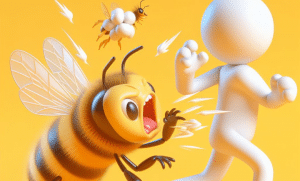
Understanding Different Bee Species
Bees are an incredibly diverse group of insects, with over 20,000 known species worldwide. These species vary in size, color, habitat, and behavior, but they all share the common trait of being important pollinators. Understanding the different species of bees can help us appreciate their unique characteristics and contributions to the ecosystem.
- Common Bee Species:a. Honeybees (Apis spp.): Honeybees are perhaps the most well-known bee species. They are social insects and live in large colonies, producing honey and beeswax.b. Bumblebees (Bombus spp.): Bumblebees are larger and fuzzier than honeybees. They are also social insects, but their colonies are much smaller. Bumblebees are excellent pollinators due to their ability to vibrate their bodies to release pollen.c. Mason Bees (Osmia spp.): Mason bees are solitary bees that nest in small holes or cavities. They are excellent pollinators and are commonly used in orchards to enhance fruit production.
- Characteristics and Behavior of Bees: a. Size and Color: Bee species can vary in size, ranging from a few millimeters to several centimeters long. They can have different color patterns, including yellow, black, brown, or metallic hues.b. Pollination Techniques: Some bee species have specialized characteristics that allow them to efficiently pollinate specific types of flowers. For example, certain bees have long tongues that allow them to access nectar from deep flowers.c. Nesting Habits: Bees can nest in various habitats, including underground burrows, tree cavities, or even man-made structures like bee boxes.
Understanding the different bee species helps us appreciate the importance of their various roles in pollination. By creating diverse habitats and supporting these different species, we can ensure their continued survival and the health of our ecosystems.
Common Bee Species
There are several common bee species that play important roles as pollinators. These species include honeybees (Apis spp.), bumblebees (Bombus spp.), and mason bees (Osmia spp.).
Honeybees are perhaps the most well-known bee species. They are social insects, with large colonies that can number in the tens of thousands. Honeybees are not naturally found in the wild, as they are domesticated for honey production. They are known for their ability to produce honey and beeswax.
Bumblebees, on the other hand, are larger and fuzzier than honeybees. They are also social insects, but their colonies are much smaller, typically numbering in the hundreds. Bumblebees are excellent pollinators due to their ability to vibrate their bodies to release pollen. They are especially efficient at pollinating certain flowers with deep, tubular shapes.
Mason bees are solitary bees that nest in small holes or cavities. Unlike honeybees and bumblebees, they do not have social colonies. Mason bees are excellent pollinators, and their efficient pollination helps enhance fruit production in orchards.
Each of these common bee species has unique characteristics and behaviors that contribute to their effectiveness as pollinators. Understanding these differences can help us appreciate their roles in maintaining the health of ecosystems and food production.
Characteristics and Behavior of Bees
Bees are fascinating creatures known for their unique characteristics and behavior. Understanding these traits can help us appreciate their importance as pollinators and dispel any misconceptions about their perceived danger.
- Social Structure: Bees are highly social insects that live in organized colonies. Within a colony, there are different castes or groups, including the queen, workers, and drones. The queen is the only reproductive female, responsible for laying eggs, while the workers are non-reproductive females that perform various tasks such as foraging, building the hive, and taking care of the young. The drones are males whose purpose is to mate with the queen.
- Communication: Bees have complex communication systems. They use pheromones, scents, dances, and vibrations to convey information to other members of the colony. For example, the waggle dance is a way for worker bees to communicate the location of a food source.
- Pollination Behavior: Bees are important pollinators due to their behavior while foraging for nectar and pollen. As they move from flower to flower, their bodies collect pollen, which they transfer to other flowers, facilitating cross-pollination. This process is crucial for plant reproduction and the production of fruits and seeds.
- Cooperative Defense: Bees have a strong instinct to protect their colony. When threatened, they may exhibit defensive behaviors, such as buzzing loudly or attempting to sting. However, bees are generally docile and will only sting as a last resort to defend themselves or their hive.
Understanding the characteristics and behavior of bees allows us to coexist with them and appreciate their vital role in maintaining the health of ecosystems and food production.
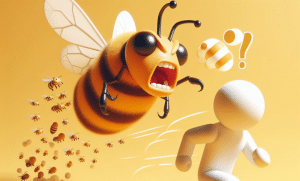
Debunking the Myth: Poisonous Bees
There is a common misconception that bees are poisonous, but this is simply not true. Bees are not Poisonous Bees insects. The confusion may arise from the fact that bees are capable of stinging, and their venom can cause discomfort or allergic reactions in some individuals. However, this does not make bees poisonous.
Bee venom is made up of various proteins and peptides, and it serves a crucial role in their defense mechanism. When a bee stings, it injects a small amount of venom into the target’s skin. This venom can cause pain, swelling, and redness at the site of the sting. In rare cases, some individuals may experience severe allergic reactions to bee stings, which can be life-threatening.
It’s important to distinguish between toxicity and the defensive nature of bees. Poisonous Bees creatures have toxins within their bodies that can harm or kill others. Bees, on the other hand, have venom glands that produce venom as a means of self-defense. It is a defensive behavior, not an inherently Poisonous Bees characteristic.
It’s crucial to understand that bees only sting as a last resort when their hive or themselves are threatened. They are generally docile and will not sting unless provoked. The best way to stay safe around bees is to be respectful and give them their space. By debunking the myth of Poisonous Bees, we can foster a greater appreciation for these important pollinators and promote their coexistence with humans.
The Misconception of Poisonous Bees
The misconception that bees are Poisonous Bees creatures has persisted for many years, leading to fear and misunderstanding. Contrary to popular belief, bees are not Poisonous Bees insects. The confusion arises from their ability to sting and the discomfort or allergic reactions that can result from their venom.
It is important to understand that bees do not possess toxins within their bodies that can harm or kill others. Instead, they have venom glands that produce venom as a means of self-defense. This venom is made up of various proteins and peptides, serving a crucial role in their defense mechanism.
The defensive behavior of bees should not be mistaken for Poisonous Bees characteristics. Bees sting only as a last resort when they or their hive are threatened. They are generally docile creatures that will not sting unless provoked.
By debunking the myth of Poisonous Bees, we can appreciate and understand their importance in the ecosystem as vital pollinators. Bees play a crucial role in pollination and the production of food, contributing significantly to the maintenance of biodiversity and the sustainability of agricultural systems.
Educating ourselves about bees and their behavior can alleviate unnecessary fear and promote coexistence with these remarkable creatures. It is crucial to respect bees’ space, avoid provoking them, and establish a harmonious relationship with them in our environment.
Explanation of Bee Venom and Its Effects
Bee venom is a complex substance produced by bees as a means of defense. It consists of a mixture of proteins and peptides that have various effects on the human body. When a bee stings, it injects its venom into the skin, leading to a localized reaction.
The main component of bee venom is melittin, which is responsible for the immediate pain and inflammation at the site of the sting. Melittin activates pain receptors, causing the characteristic stinging sensation. It also triggers the release of histamine, leading to redness, swelling, and itching.
In addition to melittin, bee venom contains enzymes such as phospholipase A2, which can cause tissue damage by breaking down cell membranes. This enzyme can contribute to the formation of a larger and more pronounced welt around the sting site.
Some individuals may have an allergic reaction to bee venom, which can range from mild to severe. Allergic reactions can include symptoms such as hives, facial swelling, difficulty breathing, and even anaphylaxis in severe cases. It is important for individuals with known allergies to bee stings to carry appropriate medication, such as an epinephrine auto-injector.
It is worth noting that the effects of bee venom can vary from person to person. While most people experience localized pain, swelling, and redness, others may have a more severe reaction. If a severe allergic reaction occurs, immediate medical attention should be sought.
Understanding the effects of bee venom can help us better manage encounters with bees and respond appropriately if stung. By learning about the true nature of bee venom, we can dispel the misconception of Poisonous Bees and foster a better appreciation for these incredible creatures.
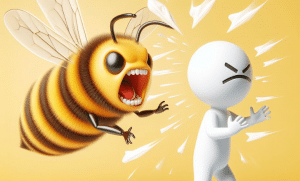
Bee Defensive Behavior and Stinging
Bees are known for their defensive nature and ability to sting when they feel threatened. It is important to understand their behavior and the circumstances that may lead to a sting.
- The Defensive Nature of Bees:
Bees are inherently protective of their hives and their colony. They exhibit defensive behavior to safeguard their resources and their queen. When they perceive a threat, they may become agitated and more likely to sting.
- Why Bees Sting and When it Occurs:
Bees sting as a means of defense. The stinger is a modified ovipositor, a female reproductive organ. When a bee stings, it injects venom into the skin, which can cause pain, inflammation, and other reactions. Bees are more likely to sting if they feel threatened, if their hive or colony is disturbed, or if they sense danger to their queen.
To mitigate the risk of bee stings, it is important to be aware of and respect their presence. Avoid sudden movements or loud noises near bees, as these can be perceived as threats. It is also advisable to avoid wearing bright-colored clothing or using floral scents that may attract bees.
In the event of a bee encounter, it is important to remain calm and slowly move away. Swatting at bees or panicking can increase the likelihood of being stung. It is also essential to seek medical attention if multiple stings occur or if an allergic reaction is suspected.
By understanding bee defensive behavior and taking appropriate precautions, we can minimize the chance of being stung and foster a more harmonious coexistence with these incredible creatures.
The Defensive Nature of Bees
Bees have a natural instinct to protect their hives and colonies, which makes them inherently defensive creatures. This defensive nature is a crucial survival mechanism for bees as it safeguards their resources, such as nectar and pollen, as well as their queen, who is essential for the colony’s continuation.
When bees perceive a threat, they can become agitated and more likely to react defensively. They are highly sensitive to disturbances around their hive and can quickly mobilize to defend it. Their defensive behavior is triggered by various factors, including sudden movements, loud noises, and vibrations. Even the presence of certain scents or bright-colored clothing can be interpreted as threats by bees.
The defensive response of bees is primarily focused on protecting the hive rather than actively seeking out people to sting. Bees would rather avoid confrontation and focus on maintaining the integrity of their colony. However, if they feel that their hive or queen is in immediate danger, they will not hesitate to defend themselves by stinging.
Understanding the defensive nature of bees is crucial when interacting with them. By being aware of their behavior and taking precautions to minimize disturbances, we can reduce the likelihood of being stung and maintain a peaceful coexistence with these remarkable creatures.
Why Bees Sting and When it Occurs
Bees sting as a defense mechanism when they perceive a threat to their hive or themselves. This stinging behavior is primarily aimed at warding off potential predators or intruders. When a bee stings, it releases a toxin called apitoxin, which is found in its venom sacs. This venom is composed of various compounds that can cause pain, inflammation, and allergic reactions in humans.
Bees are more likely to sting when they feel their hive or queen is in immediate danger. They are particularly sensitive to sudden movements, loud noises, and vibrations, which can trigger their defensive behavior. Bright-colored clothing and certain scents can also be interpreted as threats by bees, leading to an increased risk of stinging.
Additionally, bees may sting when they feel trapped or when they perceive a threat to their own personal safety. For example, if a bee accidentally gets caught in clothing or finds itself in close proximity to a person, it may feel threatened and sting in self-defense.
It’s important to note that not all bees can sting. Male bees, known as drones, do not possess stingers and therefore cannot sting. Only female worker bees and queen bees have stingers, but queen bees rarely sting unless directly threatened.
Understanding why bees sting and the circumstances that trigger their defensive behavior can help people minimize the risk of getting stung. By being aware of their surroundings and practicing caution, individuals can coexist safely with bees and appreciate their vital role in the ecosystem.
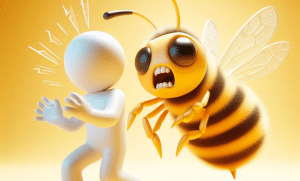
Tips for Safe Interactions with Bees
To ensure safe interactions with bees, it is important to be cautious and respect their space. Here are some helpful tips to avoid getting stung:
- Stay calm and avoid sudden movements: Bees are highly sensitive to sudden movements, so try to remain calm and move slowly when bees are around.
- Wear appropriate clothing: When spending time outdoors, especially in areas where bees are present, it is advisable to wear light-colored clothing and avoid wearing floral patterns. Bees are often attracted to bright colors and certain patterns can resemble flowers, which may increase the risk of stings.
- Avoid strong scents: Bees are attracted to sweet scents, so it is best to avoid wearing perfumes, strong-smelling lotions, or scented products when in areas with bees.
- Keep food and beverages covered: Bees are attracted to sugary substances, so make sure food and beverages are properly covered when outdoors. This will minimize the chance of attracting bees to your location.
- Stay away from beehives and nests: If you come across a beehive or nest, it is best to keep a safe distance. Disturbing a beehive can provoke defensive behavior and increase the risk of getting stung.
- Educate children about bees: Teach children to respect bees and the importance of not swatting or disturbing them. Educating children about bees can help minimize the risk of accidental stings.
By following these tips, individuals can safely interact with bees and appreciate their vital role in the ecosystem without the fear of getting stung. Remember, bees play a critical role in pollination and food production, so it is crucial to promote coexistence and respect for these incredible creatures.
Avoiding Bee Stings
To avoid bee stings, it is important to take certain precautions when spending time outdoors. Here are some tips for avoiding bee stings:
- Stay calm and avoid sudden movements: Bees are highly sensitive to sudden movements, so it is important to remain calm and move slowly when bees are present. Swatting or flailing your arms can be interpreted as a threat and may provoke a bee to sting.
- Wear appropriate clothing: When in areas where bees are present, it is advisable to wear light-colored clothing that covers your skin. Bees are often attracted to dark colors, so wearing light-colored clothing can help minimize their interest in you. It is also recommended to avoid wearing perfumes, scented lotions, or floral patterns, as these can attract bees.
- Keep food and beverages covered: Bees are attracted to sugary substances, so it is important to keep your food and beverages properly covered when outdoors. This will help reduce the chance of attracting bees to your location.
- Avoid areas with beehives or nests: If you come across a beehive or nest, it is best to keep a safe distance. Disturbing a beehive can provoke defensive behavior and increase the risk of getting stung.
By following these tips, you can minimize the risk of getting stung by bees and enjoy outdoor activities with peace of mind.
Proper Response to Bee Encounters
When encountering bees, it is important to respond appropriately to minimize the risk of getting stung. Here are some guidelines to follow for a safe response to bee encounters:
- Remain calm and still: If a bee is buzzing around you, it is crucial to stay calm and avoid sudden movements. Bees are sensitive to vibrations and may interpret sudden movements as threats, increasing the likelihood of getting stung. Stay still and allow the bee to fly away on its own.
- Do not swat or squash the bee: Swatting or trying to squash a bee can escalate the situation and lead to defensive behavior. Instead, remain still and let the bee navigate its way away from you.
- Slowly and gently walk away: If you find yourself in a situation where bees are present in large numbers or are behaving aggressively, slowly and gently walk away from the area without running or making sudden movements. Moving calmly and smoothly will help reduce the chances of provoking the bees.
- Seek shelter if necessary: If you are being pursued by bees and cannot easily walk away, seek shelter in a building or vehicle. Bees will generally not follow you indoors, allowing you to safely wait until they disperse.
Remember, bees play a vital role in our ecosystem as pollinators, and it is important to respect their presence. By responding calmly and appropriately during bee encounters, you can coexist safely with these essential creatures.
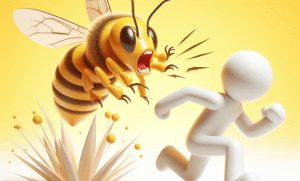
Conclusion Poisonous Bees
In conclusion, bees are incredibly important creatures in our ecosystem. They play a crucial role in pollination, which is essential for food production and maintaining biodiversity. Despite their importance, there is a common misconception about bees being poisonous. However, this is not true. Bees are not inherently poisonous, but they do possess venom that they use as a defense mechanism when they feel threatened.
The venom of a bee can cause pain, swelling, and allergic reactions in some individuals. However, it is important to note that bee stings are usually only dangerous to those who are allergic. For the majority of people, bee stings are painful but not life-threatening.
To minimize the risk of bee stings, it is important to understand bee behavior and follow proper safety precautions. Avoid sudden movements when bees are present, do not swat or squash them, and slowly and calmly walk away if necessary. Seek shelter indoors if you are being pursued by bees.
By respecting bees and responding appropriately during encounters, we can promote coexistence with these important creatures. It is crucial to overcome the fear associated with bees and educate ourselves about their vital role in our ecosystem. Through this understanding, we can protect and preserve these valuable pollinators for the benefit of our environment and food production.
Importance of Bees and Overcoming Fear
Bees play a vital role in our ecosystem and are essential for the sustainability of our environment and food production. They are responsible for pollinating a wide variety of plants, including fruits, vegetables, and flowers. Without bees, many of the crops we rely on for food would not be able to reproduce and thrive.
Despite their importance, bees are often feared and misunderstood by many people. The fear of bees can be attributed to the misconception that they are poisonous. However, as discussed earlier, bees are not inherently poisonous. While they do possess venom, they only use it as a defensive mechanism when they feel threatened.
Overcoming fear and understanding the role of bees in our ecosystem is crucial for their conservation. By learning about their behavior and the benefits they provide, we can realize that bees are more valuable than they are dangerous. Educating ourselves and others about bees helps dispel myths and fosters a sense of appreciation for these industrious creatures.
Promoting coexistence with bees involves creating an environment that supports their survival and reducing the use of harmful pesticides that can harm bees and their habitats. Additionally, by implementing practices that support sustainable agriculture, such as planting bee-friendly flowers and creating bee-friendly habitats, we can ensure the continued presence of bees in our ecosystem.
In conclusion, bees are not Poisonous Bees creatures, but rather important contributors to our environment and food production. Overcoming fear and misconceptions about bees is crucial for their conservation and the preservation of their essential role in our ecosystem. Educating ourselves and others about the importance of bees and promoting their coexistence is key to ensuring the sustainability of our environment.
Promoting Coexistence with Bees
Promoting coexistence with bees is essential for ensuring their conservation and the preservation of their vital role in our ecosystem. There are several actions individuals and communities can take to support the well-being of bees:
Plant Bee-Friendly Flowers: Creating a bee-friendly environment involves planting a variety of flowers that provide nectar and pollen for bees. Opt for native plants as they are well-adapted to the local environment and attract local bee species. Some bee-friendly flowers include lavender, sunflowers, and wildflowers.
Create Bee-Friendly Habitats: Providing suitable habitats for bees can enhance their nesting opportunities. Planting flowering shrubs or trees, installing bee houses or bee hotels, and leaving patches of bare ground or fallen logs can attract different species of bees.
Reduce Pesticide Use: Pesticides can be harmful to bees and other pollinators. Whenever possible, opt for natural pest control methods or use environmentally-friendly pesticides. Additionally, avoid spraying pesticides during bee activity times such as sunny days when bees are out foraging.
Support Sustainable Agriculture: Encouraging sustainable farming practices that minimize pesticide use and provide diverse habitats for bees is crucial. Supporting local farmers who prioritize pollinator-friendly practices can make a significant impact.
Educate Others: Spreading awareness about the importance of bees and dispelling misconceptions is vital. Taking the time to educate others about the benefits of bees and providing information on how to create bee-friendly environments can help foster greater appreciation and support for these incredible creatures.
By taking these actions, individuals and communities can play a crucial role in promoting the coexistence of bees. Together, we can create a more bee-friendly world that supports the sustainability of our environment and ensures the well-being of these invaluable pollinators.



